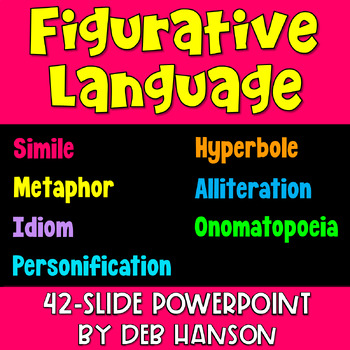Are you up for an adventure this week? A number of
fellow intermediate teacher-bloggers have joined to provide you with
blog-hopping fun this last week of January. Perhaps snow covers the
ground outside where you are reading this from, making a real outdoor hike out
of the question...so we thought we would offer you a trail to "hike
along" from the comfort of your couch!
Back in December, I was partnered up with Erin from I'm Lovin' Lit! I was ecstatic to be partnered up with Erin because we are both language arts teachers, and I have bought A TON of her items on TpT. I felt like I was partnered up with a celebrity, which I tried to explain to my husband...haha
Erin and I each selected an item from each other's stores that we could use in our classrooms this month. We both ended up picking figurative language activities! I chose Erin's "Figurative Language Stories-Close Reading for Common Core Grades 4-8" set. The set includes six original stories written by Erin, as well as four different activities that students can complete to demonstrate their abilities to 1. identify figurative language, 2. analyze figurative language, 3. Modify/Create their own figurative language, and 4. Revise figurative language. The flow of the activities builds in complexity. I was extremely pleased with how well the items in this product worked with my class's review of figurative language!
Let me start by saying that my students had some prior knowledge on the following seven types of figurative language: similes, metaphors, personification, idioms, onomatopoeia, hyperbole, and alliteration. Erin's figurative language set covers all seven of those types of figurative language, as well as allusion.
With all of the other activities I had planned for this three day school week, I used Erin's figurative language stories in a "gradual release" type model. Each step was done on a different day (as seen below).
Day 1
On our first day using Erin's figurative language stories, I thought it would be a good idea to practice how to complete two of the figurative language activities as a class, so that students would be able to complete them on their own by the end of the week. We focused on the first two activities: identifying the figurative language in the story and analyzing it. I thought that the easiest way to complete activity #1 was to color code the seven types of figurative language that we were going to identify (As I mentioned above, we hadn't studied allusion, so we just skipped that in our practice). I created a key on the board (similes=blue, metaphors=red, personification=yellow, idioms=green, hyperbole=purple, alliteration=orange, and onomatopoeia=brown), and my students got out their colored pencils and crayons. We went through the text together and identified the examples of figurative language. While I was highlighting the examples on the Smart Board, students colored them at their desks.
After we practiced identifying figurative language, we completed the second activity in the set to analyze the figurative language in the story. The second activity requires students to understand the meaning of the examples of figurative language. There are multiple choice questions and a short answer question on the bottom of the page.
Day 2
On the second day of using Erin's figurative language set, I broke my students up into four groups. Before the students got into their groups, I gave them some time to read and start identifying figurative language on their own, using the same color coding system from Day 1. Then, they met up in their groups and went over what they had found together. I reminded the students to help each other out. That if one students didn't have an answer they had, they should help explain why their answer was right. I gave the students an example that if one student labeled an example as a simile, and the other as a metaphor, they should discuss why they came up with their answer and try to come to a unanimous decision. Once the students finished identifying the figurative language in their stories, they brought up their answers to me, and thanks to Erin's answer keys, I was able to quickly check their work.
Once they were given an "okay", they were told to work on the analyzing figurative language page together. I checked their responses when they were done. The last activity they did in their groups was to create their own examples of each of the seven types of figurative language, share them with their groups, and go around explaining what their examples meant (not including alliteration and onomatopoeia, since you can't really explain the meaning of those).
Day 3
We have been studying figurative language since we got back from winter break, so on the third day of our short week, my students were given an assessment. There were multiple parts to the assessment, but the first page was the last figurative language story from Erin's set. Once again, they colored the different types of figurative language in the story, just as we had practiced. The other pages of their assessment required them to analyze and create examples of figurative language. I'm looking forward to grading my students' assessments to see how they did! :)
Erin and I each selected an item from each other's stores that we could use in our classrooms this month. We both ended up picking figurative language activities! I chose Erin's "Figurative Language Stories-Close Reading for Common Core Grades 4-8" set. The set includes six original stories written by Erin, as well as four different activities that students can complete to demonstrate their abilities to 1. identify figurative language, 2. analyze figurative language, 3. Modify/Create their own figurative language, and 4. Revise figurative language. The flow of the activities builds in complexity. I was extremely pleased with how well the items in this product worked with my class's review of figurative language!
Let me start by saying that my students had some prior knowledge on the following seven types of figurative language: similes, metaphors, personification, idioms, onomatopoeia, hyperbole, and alliteration. Erin's figurative language set covers all seven of those types of figurative language, as well as allusion.
With all of the other activities I had planned for this three day school week, I used Erin's figurative language stories in a "gradual release" type model. Each step was done on a different day (as seen below).
Day 1
On our first day using Erin's figurative language stories, I thought it would be a good idea to practice how to complete two of the figurative language activities as a class, so that students would be able to complete them on their own by the end of the week. We focused on the first two activities: identifying the figurative language in the story and analyzing it. I thought that the easiest way to complete activity #1 was to color code the seven types of figurative language that we were going to identify (As I mentioned above, we hadn't studied allusion, so we just skipped that in our practice). I created a key on the board (similes=blue, metaphors=red, personification=yellow, idioms=green, hyperbole=purple, alliteration=orange, and onomatopoeia=brown), and my students got out their colored pencils and crayons. We went through the text together and identified the examples of figurative language. While I was highlighting the examples on the Smart Board, students colored them at their desks.
After we practiced identifying figurative language, we completed the second activity in the set to analyze the figurative language in the story. The second activity requires students to understand the meaning of the examples of figurative language. There are multiple choice questions and a short answer question on the bottom of the page.
Day 2
On the second day of using Erin's figurative language set, I broke my students up into four groups. Before the students got into their groups, I gave them some time to read and start identifying figurative language on their own, using the same color coding system from Day 1. Then, they met up in their groups and went over what they had found together. I reminded the students to help each other out. That if one students didn't have an answer they had, they should help explain why their answer was right. I gave the students an example that if one student labeled an example as a simile, and the other as a metaphor, they should discuss why they came up with their answer and try to come to a unanimous decision. Once the students finished identifying the figurative language in their stories, they brought up their answers to me, and thanks to Erin's answer keys, I was able to quickly check their work.
Once they were given an "okay", they were told to work on the analyzing figurative language page together. I checked their responses when they were done. The last activity they did in their groups was to create their own examples of each of the seven types of figurative language, share them with their groups, and go around explaining what their examples meant (not including alliteration and onomatopoeia, since you can't really explain the meaning of those).
Day 3
We have been studying figurative language since we got back from winter break, so on the third day of our short week, my students were given an assessment. There were multiple parts to the assessment, but the first page was the last figurative language story from Erin's set. Once again, they colored the different types of figurative language in the story, just as we had practiced. The other pages of their assessment required them to analyze and create examples of figurative language. I'm looking forward to grading my students' assessments to see how they did! :)
She also has some other figurative language freebies: simile worksheet and simile lesson
Now, to help with your exercise for the day, here's what you
need to know about our hike and giveaway!

Hiking Tips
-Start anywhere along the trail!
-Along the way, stop by each blog and read about the
resources swapped between bloggers.
-Enter to win the resource that is featured at each blog in
the raffle below (the same raffle is at each blog, so you can just add to your
entries as you go!). While you are at each blog, if you’re not a blog follower
already, sign on to follow! (You can
earn bonus entries for following all blogs once you unlock the additional
entries.)
-The raffle is open until midnight on January
31, so feel free to take a break from your hike, rest up, and finish
it later!
One winner will receive the entire set of resources
being featured by all 14 collaborating bloggers AND a $25 TpT gift
certificate!
Here’s the list of blogs to "hike"
to:
Swap
Stop A
Swap
Stop B
Swap
Stop C
Swap
Stop D
Swap
Stop E
Swap
Stop F
Swap
Stop G
http://www.rafflecopter.com/rafl/display/dceb6232/" rel="nofollow">a Rafflecopter giveaway
Well, friends, settle in on your couch and grab
the granola. It's time to get your hike on! :)



























